Kenneth Branagh’s film of Mary Shelley’s Frankenstein reminds me of a bus station advert, and a specific one at that. In a time before mobile phones (hence no photographic proof), one particular Grand Lake bus station bench was emblazoned with a mini-billboard. It advertised a local realty firm and it read…
Why live anywhere when you can live in beautiful Alameda County?
…bad grammar making death seem like a reasonable alternative to even the remote possibility of ending up in Oakland.
Mary Shelley’s Frankenstein is like that. This film depletes one’s will to live, seeing as how there exists a quantifiable chance that you might unwittingly watch something this unendingly horrible.
This version of Frankenstein is both a tale of man’s meddling gone too far and a prime example of it. It is a relentlessly horrible tale of relentless horror. Watching it is like eating your shoe after you’ve walked through every gummy puddle on San Francisco’s Market Street. It is like having someone stand close enough to you that your noses touch and then having that someone laugh, at nothing, as loudly and wheezily as possible, for two hours, while jabbing you incessantly in the kidneys with a half-eaten human femur.
It may not have been the worst film I’ve ever seen but it is the worst film I can remember seeing.
It is also the worst film I will never be able to forget seeing.
Why watch anything when you can watch Mary Shelley’s Frankenstein?
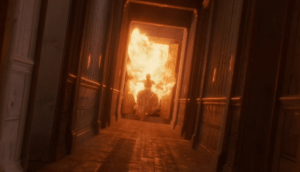 In its over two-hour length, there was only one scene that I enjoyed. That was when Helena Bonham Carter — playing Victor Frankenstein’s sister/lover Elizabeth — smashes an oil lamp over her forcibly reincarnated head. Doused in flaming combustibles, Elizabeth runs through the Frankenstein mansion like Julie Andrews swirling across a Sound of Music alpine meadow, only on fire and to her second much crispier death.
In its over two-hour length, there was only one scene that I enjoyed. That was when Helena Bonham Carter — playing Victor Frankenstein’s sister/lover Elizabeth — smashes an oil lamp over her forcibly reincarnated head. Doused in flaming combustibles, Elizabeth runs through the Frankenstein mansion like Julie Andrews swirling across a Sound of Music alpine meadow, only on fire and to her second much crispier death.
It was lovely. The ghoulish flames. The literally heartless pathos. The idea that it all could end in a grand conflagration — and as soon as possible.
The rest of the film is resolutely terrible. It is so resolutely terrible it is challenging even to break down its terribleness into sentence-sized chunks one can pass along. But, for you, I will try.
I have previously written of insane actor/director disasters. I realize now how incomplete that list was.
Mary Shelley’s Frankenstein begins near the story’s end, with Aiden Quinn’s Captain Walton. This is the film’s first character who could benefit by being overdubbed by The Count from Sesame Street but far from the last. Captain Walton is on a frenzied search for the North Pole and does not care which or how many of his crew members die in the pursuit.
Luckily for everyone, their ship is somehow solidly encased in ice approximately 12 seconds after they hit an iceberg on the open sea. From the mist-shrouded studio stage hockey rink they’re play acting on comes a hooded figure of terrifying goofiness.
This is Kenneth Branagh as Victor Frankenstein, pulling a barge bedazzled in what appear to be last year’s frocks. It is one of too few scenes in which Victor has not removed his shirt and it is possibly your last chance to flee the film unharmed.
You have been warned. Again.
Victor urges Walton to follow him without hesitation but, unlike you, Walton has caution. What is that gurgling scream in the distance? How has whatever still hides in the mist already killed all the dogs? Well. Let me tell you, at length, in the comfort of your cabin, as the monster traipses ever closer, suggests Frankenstein, somehow forgetting all the urgency with which he appeared only moments ago.
And so we go back in time to the gratingly forced frivolity of Victor’s youth, as if anyone but particularly a sea-captain in search of the North Pole who’s currently under attack by a monster could possibly give any fucks.
If you thought the fake-Arctic sets were terrible, and if you were befuddled by the early editing and costume choices, prepare yourself. Everything from here on out gets exponentially worse.
How much worse you ask? Let’s just say that by the time you see a shirtless, blood-drenched Ian Holm caterwauling down his home’s grand staircase you may begin to get the idea. If not, the following sequence, in which Branagh’s Victor charges into his dead mother’s room, literally biting his fist, should be ample answer. Above his mother’s pale corpse the distraught Victor declaims to the heavens, “No one need ever die. I will stop this!” — as if he were Patrick Swayze making fun of himself for charity.
But stopping this is beyond Frankenstein’s power, or yours. On this film will go, without pause for pacing, or mood, or even good taste, until we are all furious at Victor for denying us the peace of death. Or, at the very least, peace from Patrick Doyle’s criminally obsequious score, which yammers incessantly, as if every single moment would be the perfect time to coronate a queen or two.
Where’s that fucking oil lamp? Can I smash it over my head now and burn this whole miserable endeavor to bloody ash? What do you mean I have to wait another TWO HOURS?!?!?
To kill the time, or anything else it is in your power to kill, you might follow young Victor as he experiments with electric eels, or falls in love with his adopted sister, because that is not at all creepy. You might travel along with him to medical college, where he harangues his professors for not sharing his passion for removing his shirt and behaving unhinged. Here, for reasons irrelevant to existence across all dimensions, he is befriended by another student, Henry.
Henry is played by Tom Hulce, as if someone (*Branagh*) told him to do Amadeus again, but if he could please do his best to keep away from the scenery, as someone has already made plans to eat it (*Branagh*). The pair then run into the film’s best actor. John Cleese, wearing the heel from a clog as false teeth, brings the pair back to his secret laboratory where Hulce’s hand is squashed by an electrically re-animated monkey’s paw.
That monkey’s paw was super convincing. Never, not for one second, did I doubt that it was actually an electrically re-animated monkey’s paw, particularly when it was crushing poor Tom Hulce’s hand.
John Cleese was terrible, though. Completely. It is to his great fortune that his character gets quickly killed by Robert DeNiro‘s unnamed rogue. At this point in the film, you will likely also be hoping for a similar fate.
Should I go on? Can I? Is it possible to stop this madness without mentioning the DEATH FROG? Or the contraption Frankenstein makes to re-animate Cleese? Which contraption resembles the egg lair from Aliens crossed with a steampunk game of Mousetrap all powered by… electric eels and a hambone?
If Dr. Frankenstein ever stopped talking to himself, you might at this point enjoy what is definitively the worst Jell-O wrestling scene ever — a (naturally) shirtless Branagh pawing a Silly Putty-covered DeNiro through a swamp of snot. This is as horrific as the film gets, so if you’re sticking around for the horror: enjoy.
Although his creature lives, Frankenstein doesn’t bother to check. Instead, he takes a nap, giving DeNiro’s Creature a chance to wake up, realize that state of the film he’s in, and make straight for the exit.
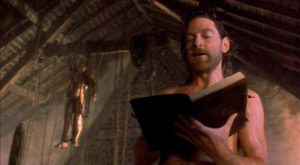
Hmm. I know I left a re-animated corpse around here somewhere? Forget it. I’ll just go to bed without a bath.
He doesn’t get far, or far enough.
The rest of the film plays out in an unending sequence of swooping camera moves, relentless running about, and enough overacting to power a mid-sized developing nation. Nothing makes the smallest lick of sense. DeNiro’s Creature is not wholly without pathos, but he never quite rises to the level of Phil Hartman’s version.
Then there’s some ice-cave nonsense, a sex scene that involves someone’s heart being punched clean out, and a love triangle between a shirtless Fabio stand-in, a Cuisinart face tester, and Emil M. Antonowsky after he’s been doused in chemical waste.
After that: fire.
Now, normally, I’d intone ‘Fire Bad’ but here, as previously mentioned, it’s the one bright spot in this unmitigated disaster. It has lustre, the fire does. It presents some genuine drama and inspires some awe. It also quite clearly signals that this film is almost over.
This makes it our last chance — with Helena Bonham Carter’s Elizabeth twice-cooked and heartless — to appraise her performance in Mary Shelley’s Frankenstein. You know what? It’s not terrible. Like poor, disrespected Tom Hulce who ends the film crying on the stairs (and wouldn’t you?), HBC does the best she can with what she’s given. And what she’s been given is Kenneth Branagh trying to strangle a goat using only his bare pectorals and his florid tongue.
The man is clearly insane. Clearly. While I’ve enjoyed some of his work — Jack Ryan: Shadow Recruit is actually totally acceptable Friday night couch fodder — this film is a step too far, and it’s a step too far into an industrial thresher filled with angry bees.
It wraps up back in the Arctic, where poor Vic has passed on, likely from talking so endlessly. The Creature emerges from the frozen mists, having politely waited for Vic to finish with his life story, and basically sits down for a cup of tea. What? Why did I kill all your sled dogs a couple of hours ago? Why have I forced Victor Frankenstein to chase me into the frigid unknown? These, Captain, are good questions.
I will pass them on, and others, to my agent.
Too bad that warm wind you just noticed has melted all the ice in a matter of seconds and now we must part. Thanks for the tea. I’ll just stay here, on this tiny iceberg with the corpse of my father, a bunch of logs you chopped from the ice trees, and this torch. No. You go. Thanks again. Don’t forget to write.
Speaking of which, this film was co-written by Frank Darabont. Yes, that Frank Darabont, who to this day wonders how Branagh managed to make his subtle take on Shelley into such a deranged mess.
It is a question for the ages.
Now, my plan is to print 10,000 of these bumper stickers — originally distributed for the film’s LA premiere — and to do my best to always get one onto Ken Branagh’s car, no matter where it may be. Even if it’s just a rental he’s in for the day. A taxicab he’d flagged down. A raft he’s swum out to in the middle of a remote lake. There, waiting for him: a message. A simple reminder.
If he finds my little prank distressing, I will simply give him the advice he gave, so generously, to all of us.
Hey Ken. Easy. Don’t bother to scream.

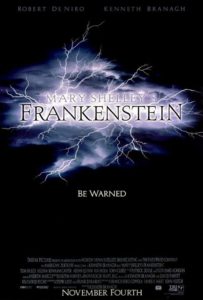
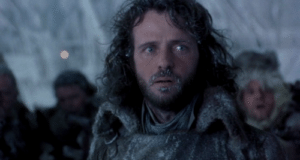
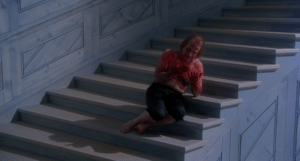
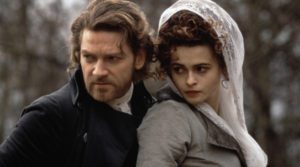
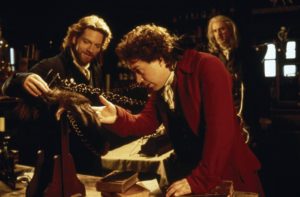
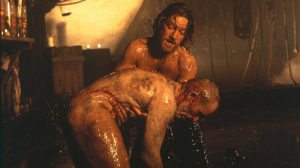
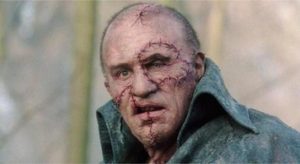
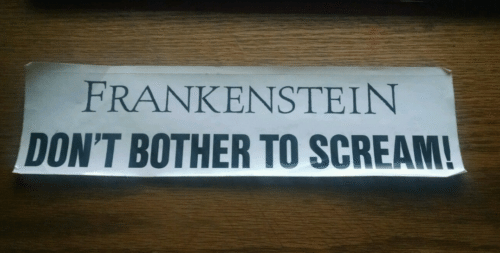
I, uh…
I feel guilt now. Incredible waves of guilt. I drove you to this, prodding you to the brink of madness and then, with a casual wave and little thought for the consequences, pushed you over the edge.
If it makes you feel better, my discourse The Wraith is coming along rather well. That probably doesn’t help, does it? Few things do, after watching Branagh’s Frankenstein. It is a mess of epic proportions, fueled by the ego of its creator. Consider yourself lucky, however, for seeing it at home, able to pause, leave, drink and return. Watching it in the theater was like being trapped with a giant, shirtless Kenneth Branagh, who regaled you with tales of his brilliance while beating you in the head with a mallet.
Your guilt may be expunged with a scholarly article on The Wraith, and also a critical investigation of The Goonies.
Oh, hell. Once I stop snerkling over your magnificent-as-always similes, I’ll be groaning in disappointment: Yet another favorite fairy-tale turns to farce on celluloid. (And unlike “Young Frankenstein,” not purposefully so.)
Why, why, why take on a project involving one of the best [monster] stories in all of literature, if you aren’t moved deeply enough by the source material to at least refrain from ruminating on the scenery?
Given the degree of self-reflexivity you’re describing—arrogant experimenter makes an ungodly, monstrous hash of a previously-revered creation—it seems redundant to talk about subversion. Perhaps Branagh was consciously aiming for this level of meta, criticism and revenues be (ahem) damned?
I have my own thoughts on why this seems to happen with fearsome regularity—but unlike yours, my narrative skills are limited to the page. I’d be interested to hear your thoughts, now or later, on why balance seems so rare in dramatic renderings of fantastic literature.
Oh…and thanks, as always, for your writing and for this blog. Yours and Supreme Being’s posts continue to be a valued and eagerly-awaited break from the mundane.
That’s the thing (and glad to see you in the comments again!): Branagh thinks, here, with this film, that he’s a GENIUS. He in no way is playing fast and loose with Mary Shelley. He likely believes he is, like Dr. Frankenstein, dabbling in the stuff of creation.
He is just as deluded and insane as Dr. Frankenstein in this regard.
I doubt he was attempting something meta.
Balance in dramatic renderings of fantastic literature: an interesting topic. Mostly, I’m going to say off the top of my head, it’s that to do creative work justice, one must bring to it an equal creativity. I.e. Fancher’s script of Blade Runner — it’s not Philip K. Dick; it’s a mad riff on Philip K. Dick. Same with Kubrick’s The Shining: not Stephen King, just born of Stephen King.
Trying to slavishly recreate fantastical works of literary fiction usually ends up like Watchmen. Amusing to see, but uninformative.
Hrm. Yes, what you say sounds intuitively as well as logically correct; I tried to find counterexamples and…really couldn’t.
The works you cited, as well as Jackson’s LoTR trilogy, the better “Harry Potter” films, Cocteau’s “La Belle et la Bete,” and so on through the history of fantastic cinema, all argue in your favor. And as a student of language and literature, it’s self-evident to me that translation is never perfect—and that the translations that best capture the spirit/beauty of the original work never stick slavishly to literal re-rendering (I’m thinking of Dante, but there are examples from every known language and era).
…I just don’t like it.
Rejecting the idea for that reason would be irrational, of course, especially in the face of my acknowledged bias: What I write is fantastic to some degree or another, and if you’re right, my work will never be compellingly translated into any other medium without being substantially changed.
Bugger.
I’ll continue to look for counterexamples (although, given our respective exposure to cinema, you’ve a far better chance of finding them). Unlike in physics, a single counterexample won’t break or reformulate the theory, but it might give me some hope of having a narrative translated without alteration. I’m very much afraid, however, that you’re correct. (And surely, despite the differences in medium, you understand as a writer the dismay of having something one struggled to piece and polish into a shining whole reassembled—if not ransacked wholesale, which King still claims of “The Shining”).
And thank you. It’s nice to have the breathing space to exchange ideas with smart, insightful people.
It’s just so hard to imagine a counterexample existing. Everything I think up, it’s either as I surmise or pretty terribly bland. Perhaps historical fiction fares better than fantasy for exactly this reason. Aiming for something real is easier to recreate. Aiming for the fantastic… too much of it is in the mind’s eye. Any interpretation will be forced or wrong.
Unless you happen to be Shane Carruth and write and direct your own stuff. So there you go. I bet Upstream Color is as close to a counterexample as we’ll find but someone, anyone, prove me wrong…
Wait. Does Fear & Loathing count? That’s pretty damned faithful and quite good.
Oh, hell, it’s been a month. Sorry. I’ve read but not seen “Fear and Loathing” and think it falls under your history exception–well, imaginative history, but still history.
It did occur to me before you mentioned it that your writing on “Upstream Color” made it an exception as well–though, as you’ve said, it isn’t really. When I read your review of it, it struck me as being similar to “Pan’s Labyrinth”–a fairy tale from head to screen, with no print intermediary.